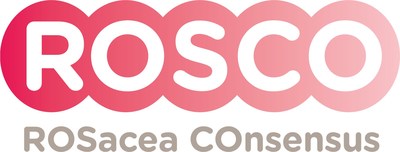Newly Published ROSacea COnsensus (ROSCO) Expert Recommendations Encourage Dermatologists to Upweight Burden-related Discussions, Aim For 'Complete Clearance' of Symptoms and Consider Combination Therapy For Severe Patients

LAUSANNE,Switzerland,Sept. 9,2019 --Published online in the British Journal of Dermatology,updated global recommendations from the ROSacea COnsensus (ROSCO) expert panel call on dermatologists to recognize the importance of disease burden discussions,recommending the use of four specific questions to assist these conversations in practice. Additionally,in light of evidence showing the clinical benefits of patients reaching 'clear' (IGA 0)*,the panel recommends that "complete clearance" of symptoms should be the primary objective of any treatment regimen to reduce impact on quality of life and maximize patient satisfaction.1
The rosacea treatment algorithm,developed by ROSCO in 2017,has been updated with several new recommendations including the use of combination therapy to benefit severe patients and those presenting with multiple features,in line with latest clinical evidence.1-3
"Rosacea can sometimes present as a single feature,or more often as a combination of features. Once we correctly diagnose our patients,and truly understand their disease burden – both the visible and non-visible impact – aiming for 'clear' (IGA 0) is possible,resulting in improved quality of life,longer time to relapse,as well as reduced social and productivity burden." said ROSCO Panel Co-Chair Prof. Dr. Martin Schaller,Deputy Medical Director,Department of Dermatology,Tübingen University,Germany. "Given the significant benefits associated with achieving 'clear',it should become best practice to aim for complete clearance of symptoms,working closely with our patients to monitor their progress and adjust treatment accordingly."
ROSCO experts also recognize that previous guidance about transitioning towards a rosacea signs and symptoms-led approach to diagnosis,has been well received,with a rise in adoption and advocacy of the phenotype approach† in standard clinical practice.1-3
ROSCO expert feedback has also been used to develop the Rosacea Tracker prototype tool,a clinical checklist to help dermatologists surpass challenges to implementing the phenotype algorithm in clinical practice. Additional consensus was gained on 7 patient case studies representing the common rosacea phenotypes,providing support for dermatologists to identify these phenotypes in everyday practice.1
"Optimizing management of our rosacea patients is crucial. This new clinical tool can provide an ongoing record of a patient's rosacea features and helps assess changes over time including their impact and treatment response," said ROSCO Panel Co-Chair Prof. Dr. Jerry Tan,Adjunct Professor,Western University,Windsor,Ontario,Canada. "There have not previously been easy-to-use,point of care tools to assess all rosacea phenotypes. By using the ROSCO recommended methodology and tools,we aim to improve and advance the care of patients with this chronic skin disease."
The latest ROSCO recommendations provide a basis for local guideline development to further improve the management of rosacea,and thus improve outcomes,for rosacea patients globally.
* The success of rosacea treatment is usually defined as a score of 1 ('almost clear') or 0 ('clear') on the 5-point Investigator Global Assessment (IGA) scale. Several studies have shown that patients who achieve 'clear' (IGA 0),a complete reduction in symptoms,experience an extended time to relapse and an improved quality of life compared with patients who are 'almost clear' (IGA 1)4
† A phenotype approach allows for rosacea diagnosis and management according to a patient's presenting disease features,rather than grouping into pre-specified subtypes1
References:
Schaller M,et al. Recommendations for rosacea diagnosis,classification and management: Update from the global ROSacea COnsensus (ROSCO) 2019 panel. Br J Dermatol. 2019 Aug 7. doi: 10.1111/bjd.18420 [Epub ahead of print].
Tan J,et al. Updating the diagnosis,classification and assessment of rosacea: Recommendations from the global ROSacea COnsensus (ROSCO) panel. Br J Dermatol. 2016 Oct 8. doi: 10.1111/bjd.15122.
Schaller M,et al. Rosacea treatment update: Recommendations from the global ROSacea COnsensus (ROSCO) panel. Br J Dermatol. 2016 Nov 12. doi: 10.1111/bjd.15173.
Webster G et al. J Dermatolog Treat. 2017;28(5):469-474.
Notes to Editors
About Rosacea
Rosacea is a common inflammatory skin disease that presents variable clinical characteristics,of which the most common are flushing,permanent erythema,and inflammatory lesions. It mainly affects the central areas of the face,such as the cheeks and nose. The disease can affect both adult men and women,usually after the age of 30. Additionally,symptoms such as stinging,burning and increased sensitivity of the skin are common. The eyes are often affected,and might present as red,dry or itchy.
Although the cause of the disease is still under debate,various trigger factors are known,including spicy foods,alcohol,emotional stress,sun/UV-exposure,hot baths and beverages. Demodex,generally harmless mites,can also be found in the skin in an elevated quantity in people with rosacea. Rosacea may worsen over time if left untreated. People that suspect they suffer from rosacea should visit their dermatologist or healthcare provider for diagnosis and discuss what treatment is right for them. Because rosacea is a highly visible disease,it is known to cause embarrassment and anxiety in some patients,which in turn may cause frustration and have a negative impact on their social life.
About the Global ROSacea COnsensus (ROSCO) 2019 panel
The Global ROSacea COnsensus (ROSCO) 2019 expert panel included 19 dermatologists from Argentina,Brazil,Canada,France,Germany,India,Italy,the Netherlands,Qatar,Singapore,South Africa,the U.K and the U.S.A,and two ophthalmologists from Germany and the U.S.A. Panel members reached consensus on critical aspects of rosacea diagnosis and treatment by a modified Delphi approach (e-surveys and group virtual meeting),by voting on each statement: strongly disagree,disagree,agree or strongly agree (consensus defined as ≥75% agree/strongly agree). Statements that did not reach consensus in e-surveys were refined through nominal group discussion at the meeting and re-voted on. All voting was electronic and blinded.
Galderma funds the creation of ROSCO expert panel meetings and e-surveys,but is not involved in the voting,discussion or handling of data.
About the British Journal of Dermatology
The journal is published by Wiley on behalf of The British Association of Dermatologists,the central association of practising UK dermatologists. The organization's aim is to continually improve the treatment and understanding of skin disease. For further information about the charity,visit www.bad.org.uk.
Wiley is the international scientific,technical,medical,and scholarly publishing business of John Wiley & Sons,with strengths in every major academic and professional field and partnerships with many of the world's leading societies. For more information,please visit www.wiley.com.
Logo - http://cusmail.com/res/2023/07-22/18/24824436638455e258a0b38469a020fa.jpg